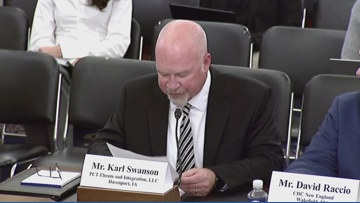Report on the Mississippi House Education Freedom Select Committee’s Inaugural Meeting and Alignment with Sustainable Development Goals
1.0 Introduction and Procedural Framework
The Mississippi House of Representatives has established the Education Freedom Select Committee to conduct informational hearings in preparation for the 2026 legislative session. This initiative, announced by Speaker Jason White, reflects a commitment to evidence-based policymaking, a principle that underpins the successful implementation of the Sustainable Development Goals (SDGs). The committee’s inaugural meeting is scheduled for August 25 at the State Capitol. The focus of this body is to explore policy options related to school choice, a topic with significant implications for several SDGs.
2.0 Advancing SDG 4: Quality Education
The committee’s primary mandate directly addresses SDG 4: Ensure inclusive and equitable quality education and promote lifelong learning opportunities for all. The exploration of “Education Freedom” is an inquiry into alternative models for delivering quality education. The committee’s agenda is designed to evaluate how different approaches can enhance educational outcomes across the state.
- Policy Exploration: The committee will consider various forms of school choice, including public-to-public transfers and mechanisms allowing state funds to support private school tuition.
- Goal Alignment: These considerations are aligned with SDG Target 4.1, which aims to ensure that all girls and boys complete free, equitable, and quality primary and secondary education leading to relevant and effective learning outcomes.
3.0 Addressing SDG 10: Reduced Inequalities
The debate over school choice is intrinsically linked to SDG 10: Reduce inequality within and among countries. By examining policies that could provide diverse educational opportunities, the committee is investigating potential pathways to mitigate disparities in educational access and quality that often correlate with socioeconomic status.
- Equity Focus: The initiative seeks to empower parents and students, potentially providing pathways to higher-quality education for those in underserved communities, thereby addressing SDG Target 10.2 to empower and promote the social and economic inclusion of all.
- Outcome Equality: A central objective is to foster an educational landscape that promotes equal opportunity and reduces inequalities of outcome, as stipulated in SDG Target 10.3.
4.0 Featured Experts and Contribution to SDG 5: Gender Equality
The selection of Dr. Lauri Todd-Smith and Dr. Lindsey Burke as the sole speakers for the first meeting highlights women’s leadership in high-level policy discourse, directly supporting SDG 5: Achieve gender equality and empower all women and girls. Their expertise demonstrates the critical role of women in shaping public institutions and policy, aligning with SDG Target 5.5, which calls for women’s full and effective participation and equal opportunities for leadership.
4.1 Profile: Dr. Lauri Todd-Smith
- Public Service: Currently serves as Deputy Assistant Secretary for Early Childhood Development at the U.S. Department of Health and Human Services, overseeing critical programs like Head Start. This work is fundamental to SDG Target 4.2, ensuring access to quality early childhood development.
- Policy Expertise: Has advanced evidence-based education policy reforms, including the expansion of school choice and early literacy programs, which are essential for achieving quality education (SDG 4).
- Advocacy: Her work in foster care reform and child safety aligns with broader goals of protecting vulnerable populations, a cross-cutting theme in the SDGs.
4.2 Profile: Dr. Lindsey Burke
- Governmental Role: Serves as Deputy Chief of Staff for Policy and Programs at the U.S. Department of Education, influencing national educational strategy.
- Research and Academia: Formerly the Director of the Center for Education Policy at the Heritage Foundation, with peer-reviewed research published in academic journals. This commitment to data-driven analysis supports the monitoring and accountability frameworks required for the SDGs.
- Institutional Engagement: Affiliations with EdChoice and the Educational Freedom Institute underscore a deep involvement in policy development aimed at improving educational systems.
5.0 Institutional Integrity and SDG 16: Peace, Justice, and Strong Institutions
The formation of a select committee to study a complex issue before legislative action is a practical application of SDG 16: Promote peaceful and inclusive societies for sustainable development, provide access to justice for all and build effective, accountable and inclusive institutions at all levels. This methodical approach ensures that future legislation is well-informed and deliberated, reflecting the principles of SDG Target 16.6 to develop effective, accountable, and transparent institutions.
Analysis of the Article in Relation to Sustainable Development Goals
-
Which SDGs are addressed or connected to the issues highlighted in the article?
The article addresses issues primarily connected to two Sustainable Development Goals:
- SDG 4: Quality Education: The central theme of the article is the Mississippi House Education Freedom Select Committee’s meeting to discuss education policy. It explicitly mentions “school choice,” “early literacy programs,” “preschool, K-12 and higher education,” and “early childhood development.” These topics are at the core of ensuring inclusive and equitable quality education.
- SDG 16: Peace, Justice and Strong Institutions: The article mentions that Dr. Todd-Smith has advocated for “foster care reform and the safety of children on the Internet.” These issues are related to protecting children from abuse and exploitation, which is a key component of SDG 16.
-
What specific targets under those SDGs can be identified based on the article’s content?
Based on the article’s content, the following specific targets can be identified:
- Target 4.1: Ensure that all girls and boys complete free, equitable and quality primary and secondary education. The committee’s focus on K-12 education policy and “all forms of school choice” is aimed at reforming the system to improve educational outcomes for students in primary and secondary schooling.
- Target 4.2: Ensure that all girls and boys have access to quality early childhood development, care and pre-primary education. This is directly addressed through the expertise of Dr. Todd-Smith, who is the Deputy Assistant Secretary for Early Childhood Development and leads the Office of Early Childhood Development, which oversees the Office of Head Start and Office of Child Care. The discussion of preschool policy is also relevant here.
- Target 4.5: Eliminate gender disparities in education and ensure equal access to all levels of education… for the vulnerable, including… children in vulnerable situations. The mention of “foster care reform” in conjunction with education policy suggests a focus on improving educational access and outcomes for children in the foster care system, who are a vulnerable group.
- Target 16.2: End abuse, exploitation, trafficking and all forms of violence against and torture of children. Dr. Todd-Smith’s advocacy for “foster care reform and the safety of children on the Internet” directly relates to this target, as both initiatives are aimed at protecting children from harm, abuse, and exploitation.
-
Are there any indicators mentioned or implied in the article that can be used to measure progress towards the identified targets?
The article does not mention explicit statistical indicators. However, it implies areas where measurement would be necessary to assess the impact of the proposed policies. These implied indicators include:
- Implied Indicator for Target 4.1: The mention of the “expansion of early literacy programs” implies a focus on improving reading skills. Progress could be measured by the proportion of students achieving minimum proficiency levels in reading and mathematics.
- Implied Indicator for Target 4.2: Dr. Todd-Smith’s role overseeing the Office of Head Start and Office of Child Care implies a focus on enrollment in early education. Progress could be measured by the participation rate in organized learning (one year before the official primary entry age).
- Implied Indicator for Target 4.5: The focus on “foster care reform” within an educational context implies a need to track the educational progress of this vulnerable group. An indicator would be the parity in educational outcomes (e.g., graduation rates, proficiency levels) for children in foster care compared to the general student population.
- Implied Indicator for Target 16.2: The advocacy for “safety of children on the Internet” and “foster care reform” implies a goal of reducing harm to children. Progress could be measured by the number of reported cases of online exploitation of children or rates of abuse and neglect within the foster care system.
-
Create a table with three columns titled ‘SDGs, Targets and Indicators” to present the findings from analyzing the article.
SDGs Targets Indicators (Implied from the article) SDG 4: Quality Education 4.1 By 2030, ensure that all girls and boys complete free, equitable and quality primary and secondary education. Proportion of students achieving minimum proficiency levels in reading, linked to the “expansion of early literacy programs.” SDG 4: Quality Education 4.2 By 2030, ensure that all girls and boys have access to quality early childhood development, care and pre-primary education. Participation rate in organized learning, linked to the work of the Office of Head Start and Office of Child Care. SDG 4: Quality Education 4.5 By 2030, ensure equal access to all levels of education for the vulnerable. Parity in educational outcomes for children in vulnerable situations, linked to the advocacy for “foster care reform.” SDG 16: Peace, Justice and Strong Institutions 16.2 End abuse, exploitation, trafficking and all forms of violence against and torture of children. Rates of child abuse, neglect, and online exploitation, linked to “foster care reform” and “safety of children on the Internet.”
Source: magnoliatribune.com







